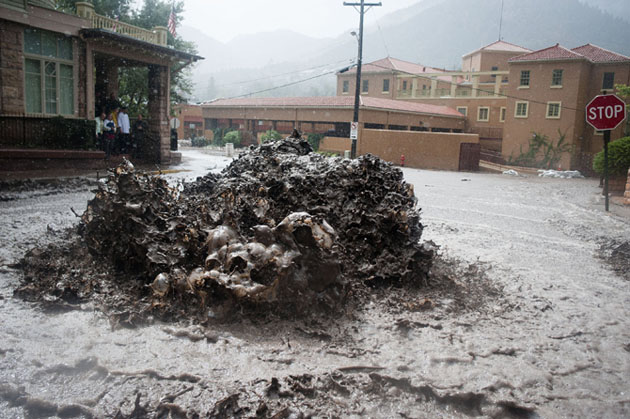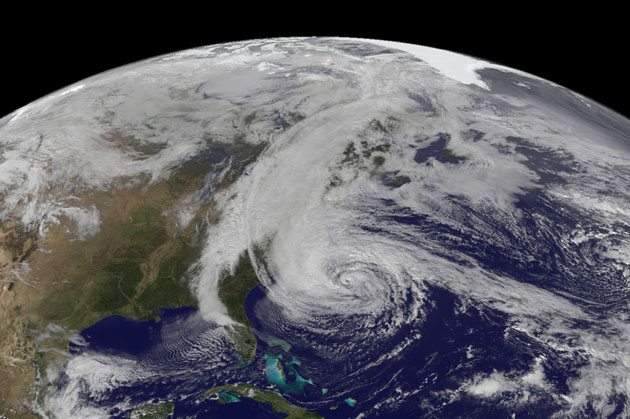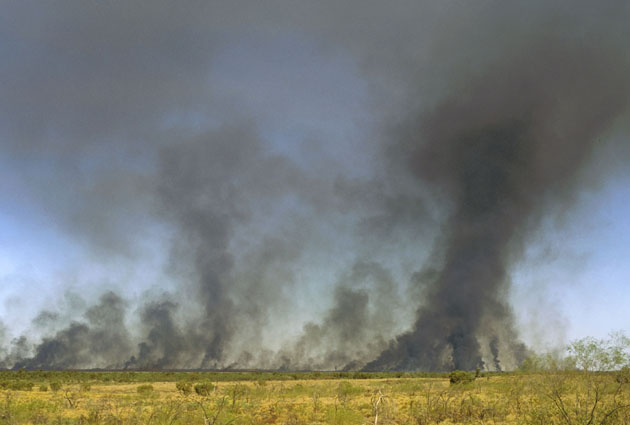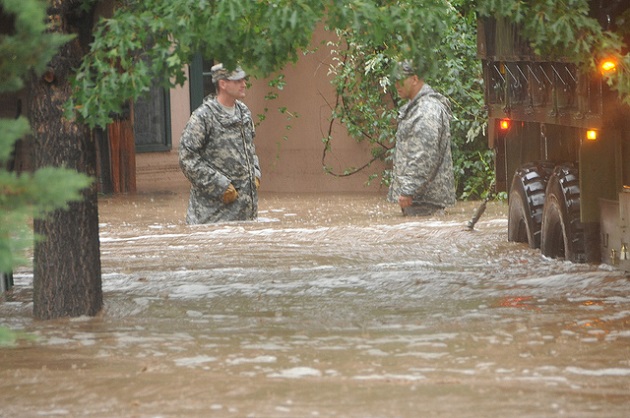
Colorado National Guard/FlickrTwo Colorado National Guardsmen waist deep in Boulder floodwaters.
Last Thursday, as torrential rains turned into floods that washed away homes, roads, and bridges in Boulder, Colorado, and the surrounding region, the local National Weather Service forecast office went ahead and said what we were all thinking. It put it like this:
MAJOR FLOODING/FLASH FLOODING EVENT UNDERWAY AT THIS TIME WITH BIBLICAL RAINFALL AMOUNTS REPORTED IN MANY AREAS IN/NEAR THE FOOTHILLS.
The word “biblical” certainly captures the almost preternatural scale of the Colorado floods, and the rainfall that caused them. Indeed, according to climate scientist Martin Hoerling of the National Oceanic and Atmospheric Administration, “this single event has now made the calendar year (2013) the single wettest year on record for Boulder.”
But does that mean that climate change is involved? Although suggestive, broken records alone do not constitute definitive proof that humanity’s fingerprints have been left on a particular weather disaster. On the other hand, climate scientists say with considerable confidence that a hotter planet will feature more extreme rain events, much like this one.
So what can actually be said about the Colorado floods in a climate context?
Just how extreme was this event? First off, it’s important to get a sense of how out-of-the-ordinary these floods—which have killed eight people and left hundreds unaccounted for—really were. That’s not difficult; superlatives have hardly been lacking to describe the event. Remarking on the “epic deluge,” meteorologist Jeff Masters, co-founder of the popular Weather Underground site, had this to say:
According to the National Weather Service, Boulder’s total 3-day rainfall as of Thursday night was 12.30″. Based on data from the NWS Precipitation Frequency Data Server, this was a greater than 1-in-1000 year rainfall event. The city’s previous record rainfall for any month, going back to 1897, was 9.59″, set in May 1995. Some other rainfall totals through Thursday night include 14.60″ at Eldorado Springs, 11.88″ at Aurora, and 9.08″ at Colorado Springs. These are the sort of rains one expects on the coast in a tropical storm, not in the interior of North America!
So what caused such a deluge? That the rains were reminiscent of a tropical storm gives a hint as to how this occurred. What fell over Colorado last week was, in significant part, tropical moisture, pulled up all the way up to the Rockies from the Mexican coast by a confluence of atmospheric events. Furthermore, the rainfall on the Front Range was exacerbated by a so-called atmospheric “blocking pattern,” which produced a situation of stuck weather, in which one pattern (unending rain) persisted for a long period of time. “We had this giant cutoff low sitting over Salt Lake City, dredging up a continuous stream of tropical moisture,” explains Minnesota meteorologist Paul Douglas, who is founder of the Media Logic Group and has been frequently outspoken about the reality of climate change from a Republican political perspective.
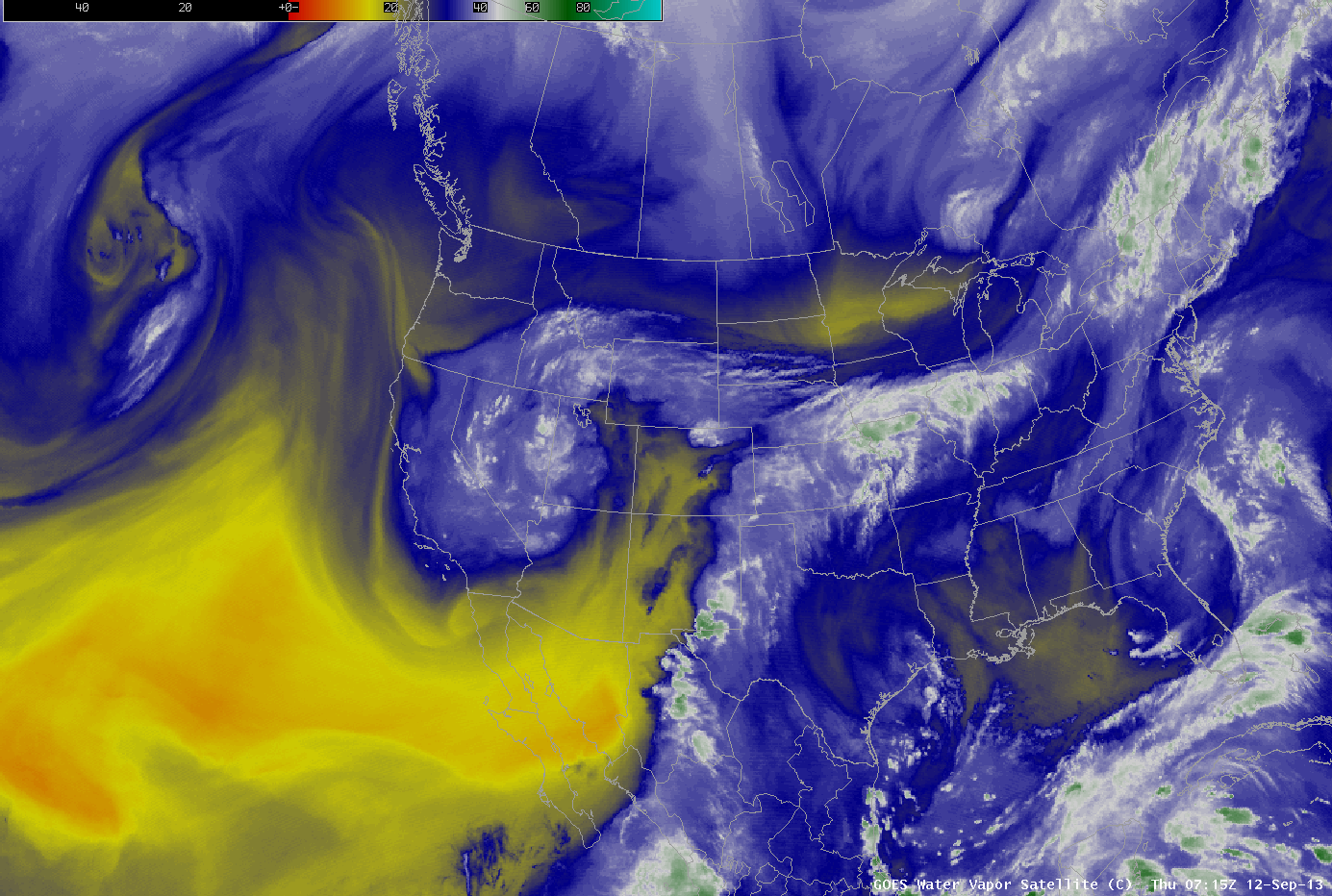
And here’s the first possible climate linkage: The idea that the jet stream has been altered as a result of climate change, leading to more stuck weather and more blocking patterns, is a serious one, and one that has also been brought up in relation to the odd behavior of Superstorm Sandy. “I’ve noticed since last September, since the record ice loss in the Arctic, that the jet stream has been misbehaving, more blocking patterns in general over the northern hemisphere,” says Douglas.
He’s not the only one: Jennifer Francis of Rutgers University has led the scientific charge when it comes to the connection between Arctic sea ice loss and mid-latitude weather extremes (for further explanation, see here). And while the issue remains debated, it’s certainly possible that global warming is making blocking patterns, like the one that helped produce the Colorado floods, more likely to occur on average.
Doesn’t climate change produce more extreme rainfall, period? The idea that there will be more extreme rainfall, in general, in a warming world is very well established scientifically at this point. “The science about future increases of extreme rainfall is very solid, just because we have a good understanding of the physics of it,” says Claudia Tebaldi, a climate scientist and statistician with Climate Central and the National Center for Atmospheric Research. “Warmer air is going to hold more moisture,” Tebaldi continues, “so when something happens, there is going to be more available water to precipitate on us.”
[If you want to get your inner nerd on about why this is the case, the answer is the Clausius-Clapeyron equation, which states that as atmospheric temperatures increase, the amount of water vapor that the air can contain increases exponentially. For a good explanation, see here.]
How much extra water vapor are we talking about here? “For 1 degree Fahrenheit, it’s something like 5 percent more moisture in the atmosphere,” explains climate scientist Kevin Trenberth of the National Center for Atmospheric Research (which itself happens to be in Boulder). That extra water vapor, according to Trenberth, helps fuel and strengthen storms, even as it also gives them an added moisture supply, meaning that the net effect on increased rainfall may be 5 to 10 percent. For Trenberth, that would therefore mean that climate change contributed somewhat to the Colorado floods, but that’s very different from saying that it caused the entire event. “You can’t blame this thing on climate change,” he says.
Martin Hoerling of NOAA comes to a similar conclusion. “Global warming has led to an increase in the atmosphere’s water holding capacity, and empirical studies indicate a few [percent] of increase in water vapor to date,” he comments by email. That means that the majority of the moisture over Colorado was there not due to global warming per se, but simply because of the aforementioned atmospheric circulation patterns.
Are extreme rainfall events increasing, as predicted? Absolutely. NOAA’s National Climatic Data Center keeps extensive data on weather extremes, and has found that since the 1970s, there has been an uptick in one-day extreme precipitation events:
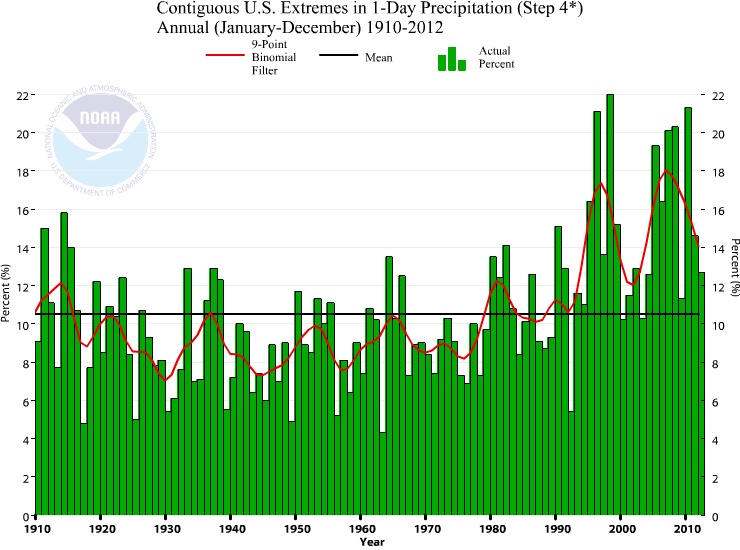
An increasing trend in extreme rains is also supported by the recently leaked draft of the Intergovernmental Panel on Climate Change’s Fifth Assessment Report. The draft says that it is “very likely” that central North America has already seen a trend toward more extreme precipitation events and that there is “medium confidence” that humans have contributed to this change. In the future, moreover, this trend is expected to continue. According to the IPCC draft, “in a warmer world, extreme precipitation events over most of the mid-latitude land masses and over wet tropical regions will very likely be more intense and more frequent by the end of this century.”
In this sense, the Colorado Floods are consistent with the general picture of what we’ve been seeing, and what we would expect to see, under climate change. That doesn’t make them directly caused by climate change, but it does put them in context.
What about Colorado’s climate future in particular? The future precipitation forecast for Colorado itself is less certain. The U.S. National Climate Assessment, which is currently in draft form, includes regional projections for how temperature and rainfall changes are expected to affect different parts of the United States. The report includes Colorado in the country’s Southwest region, which overall has seen a 12 percent increase in heavy precipitation since the year 1958 (considerably less than some other regions). Going forward, the southern part of the Southwest region, including states like Arizona and New Mexico, is actually expected to see a decrease in precipitation. But the picture isn’t as clear for Colorado; according to the National Assessment draft, projections aren’t in agreement with each other. However, even in areas where average rainfall is expected to decline, the percentage of overall precipitation falling in extreme downpour events is expected to increase. In other words, the shift remains towards more extremes.
And now for the really tough question: Did global warming in any way “cause” this event? So far, we’ve established that the Colorado floods are consistent with expected climate trends: more extreme rains (pretty certainly), and possibly more blocking patterns (still a new and debated issue). And we’ve also suggested that rainfall in this particular event may have been amplified, somewhat, by climate change.
But causation? That’s a very different, much knottier issue, as Kevin Trenberth’s remark above (“You can’t blame this thing on climate change”) makes clear. In fact, Trenberth himself has argued prominently that “no events are ’caused by climate change’ or global warming, but all events have a contribution.” The issue is further complicated by a large gap between how scientists understand the word “cause,” and how the lay public does.

Ordinarily, we think about “cause” in a simple sense in which one thing fully brings about another. Thus, I tripped and fell, and this caused me to have a bump on my head. But in the atmosphere, it’s hardly so simple. As we’ve seen, the Colorado floods were partially caused by moisture from the tropics, partly caused by a blocking pattern that held one weather system in place for an extended period of time, and perhaps also partly caused by past wildfires that increased the risk of runoff (to name just a few partial causes). The cognitive linguist George Lakoff has introduced the distinction between “direct causation” and “systemic causation” to help us tackle this sort of problem. The latter form of causation is not direct; rather, it is diffuse, partial, and usually captured in statistical relationships. But it is no less real for this reason, or less amenable to scientific analysis.
In the past, scientists have demonstrated, for a few individual events, that global warming made them more likely to occur in a statistical sense. That includes the 2003 heat wave in France, and a particularly devastating UK flood in 2000. (For an explanation, see here.) More recently, researchers at the National Oceanic and Atmospheric Administration and the UK Met Office released a landmark study on 2012’s extreme weather events, and whether climate change was involved, finding a role in some of them but not others. For instance, climate change was found to have made July 2012’s heat wave in the U.S. as much as four times more likely to occur, and increased the likelihood of the US’s anomalous March-May 2012 warmth by as much as 12 times. But no role was found for the 2012 US drought.
Not surprisingly, such an analysis has not yet been performed for the 2013 Colorado floods, but it surely will be. And what will be the result? That’s unclear. “With precipitation events it’s much harder than with heat waves,” explains Claudia Tebaldi, “because of these two aspects that combine, the thermodynamic and the dynamic.” The thermodynamic is the easy part: There’s more moisture, due to a warmer atmosphere. There’s physics on that. But the dynamics—whether, in a world without global warming, the atmospheric flow that created this event would still have occurred…well, that’s extraordinarily difficult to unravel.
So what’s the bottom line? With every extreme weather event nowadays, from Superstorm Sandy to the Colorado floods, there’s a strong inclination to link it to climate change. But once you get into the details, the word “link” becomes far too vague: Each event is different, and the ways in which it may or may not relate to a changing climate are also varied. Partial contributions may be present—global warming exacerbated Sandy’s storm surge through sea level rise, and probably contributed to some percentage of the rainfall over Colorado—and individual events may be consistent with larger trends. But ultimate “causal” connections remain difficult to establish and, according to Trenberth, the very attempt itself may be missing the point.
The real question is: Why would we expect it to be otherwise? When you conduct a massive experiment with only one planet as your test subject—or as scientists would put it, an experiment with an N of 1—this is the situation you create. And the proper way of thinking about that situation is clear: Even when you can’t be definitive, you can definitely be worried.
